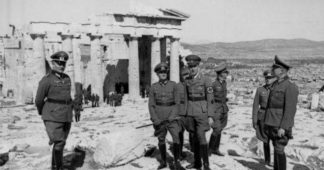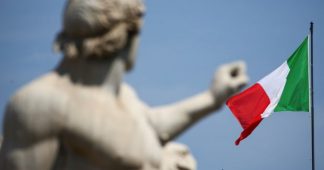Book Author: Vaggelis Sakkatos
BOOK Title: “Kefalonia 1943”
The Big Crime of the Nazis
The Slaughter of the Acqui Division
Documentaries and Texts
Gerasimos Galanos
A Moving Historical Testimony
Vivliofilia, Athens, August 2008
The National Herald Book Review by Dr Demosthenes Kostas/Konstantatos, who lived through those 1943 events in Kefalonia follows
BACKGROUND
The book “Kefalonia 1943” by Vaggelis Sakkatos, published in 2008 Athens, is a follow-up to the earlier two editions of his autobiographical historical novel, “Acqui Division: The Massacre of the Italians in Kefalonia. The resistance”. In contrast to his previous book (recently published in Italian) the new book establishes the historical foundation of the 1943 events in Kefalonia.
“Kefalonia 1943” is thus an important historical book that documents the massive 1943 war crimes committed in Kefalonia by the German Edelweiss Division that slaughtered in cold blood thousands surrendered Italians of the Acqui Division and about three hundred Kefalonites. It is one of the worst barbaric and unpunished crimes of the World War II. The current total of Italians killed by Germans in Kefalonia quoted by the book is 9,640. The massacre took place in collusion and in conspiracy with the British, who sent their agents to Kefalonia and forcefully persuaded the twelve thousand Italians occupying Kefalonia to rise against the Germans, while falsely promising them that the British will then land to support them. When the Italians arose against the Germans the British abandon them. After a week of German Stukas massive collective bombardment of Kefalonia, without any Anglo-American support, and the Italian supplies running low, the Italian command unconditionally surrendered on September 22, 1943. It should be noted that not only the British did not assist the Italians in Kefalonia but they also ordered two Italian ships loaded with supplies on their way to Kefalonia to return to Brindizi.
It seems that the British encouraged the Italians’ uprising in Kefalonia to confuse the Germans on whether the Anglo-Americans were going to land in Greece or Southern Italy.
Major Herald von Hirschfeld, commander of the Wehrmacht (German-Austrian) Edelweiss Division that landed in Kefalonia Septembr 1943
KEFALONIA 1943
Mr. Sakkatos, an octogenarian author and journalist, having suffered and survived WWII and the civil war in Kefalonia seeks through his books to uncompromisingly disseminate information on war criminals and their crimes and thus thwarting criminals and opportunists from spreading misinformation to hide their crimes, for financial gain, and other self serving purposes.
The Kefalonia 1943 book describes the German massacre and is full of relevant interviews, disclosures of atrocities by Edelweiss soldiers, legal depositions to the war crimes responsible German District Attorney, historical seminars, commentaries and literary criticisms of other books and news media articles on the subject.
Of great historical interest is the inclusion of a 1943 letter of a school teacher on his experiences in Argostoli. Gerasimos Galanos, a school teacher, wrote a letter to his daughter in Athens on September 1943 accurately and vividly communicating the upheaval, terror, tragedies, and destruction caused by the massive incendiary German bombing of Argostoli. The reviewer was then living in Argostoli.
The author lashes out at Louis de Bernieres, the writer of the “cold-war” mentality book and its Hollywood movie named “Corelli’s Mandolin” ( called the “Gestapo’s Mandolin” by the Sunday Eleutherotypia) for its historic fabrications(plastografies) and calumnies (sykofanties)against the Greek Resistance, the Acqui Division’s uprising and its massacre by the German Wehrmacht. Similar criticisms for Corelli’s Mandolin are quoted from Italian, German, British, and Greek news media. The author quoting from de Bernieres novels outrageous anti-Greek (and anti Balkan ethnicities) views and his complimentary characterizations of the Ottoman soldiers as saintly, blameless, and sinless. The author suspects that the source of de Bernieres’ information is likely to be derived from Gestapo and/or the Inteligence Service.
A positive comment made about the “Mandolin” is that it globally raised the awareness of the 1943 German brutal massacre, that for “cold war” political reasons, the global news media had not covered previously. The German justice when confronted with the evidence on German war crimes in Kefalonia, ignored the decision made at the Nuremberg trials after WWII and released the criminals with the excuse that they were just carrying out orders. Thousands murdered and no one punished! Similarly unpunished were the German WWII massacres of Greeks in Distomo, Kommeno, Kalavrita, Kontomariou, Pyrgoi, …. Some of the Germans that committed war crimes in Greece( e.g., Hubert Lanz and Max Merten ) were tried, were given light sentences and soon thereafter released. Many German war criminals after release were soon recycled giving them high posts in the West German government or military. It is noted that the Italian and Greek governments also bear responsibility, as they did not pursue these German war crimes charges at the time so as not to disturb the German presence in the Atlantic Alliance. That the interior minister Makris (of the late 1950s Karamanlis government) speaking in Parliament about those that were against the release of Max Merten said that, the Left are traitors and that he prefers the war criminals to the communists, is indicative of the unfair mentality of the government at that time.
Mr Sakkatos also criticized the Nea Dimocratia Minister Gerasimos Apostolatos for writing in the Greek daily “Kathemerini”(9/21/2003) that the Acqui Division was mislead to rise against the Germans by a small group of local leftists and some young irresponsible Acqui officers. This explanation ignored the British role in pressuring Acqui’s leadership to takeover Kefalonia, that the decision to fight the Germans was democratically made by the Italians in Kefalonia, and that the accusations made by Mr. Apostolatos about the Acqui Division officers were wrong. Similarly some Italian government officials are accused of not pursuing justice for this hideous crime, but covering German war criminals, and blaming the Acqui Division victims for their misfortune.
Reports are included on periodically conducted well attended international commemorative seminars on the Kefalonia 1943 German war crimes. Participants included writers, historians, government officials, Acqui Division survivors and their relatives, and students. Seminars include presentations on new historically relevant findings, government official speeches and cultural events.
While a number of books have been written in Greek and Italian about the German war crimes in Kefalonia, the “Kefalonia 1943” book is a well written, brief and accurate source of up to date historical information in Greek, written by one who was in Kefalonia during the war.
Demosthenes Konstantatos (Kostas) Ph.D. M.Sc. M.B.A











